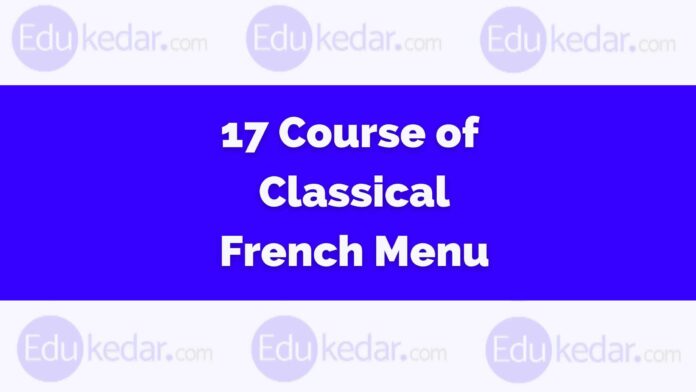The French classical menu consists of a 17-course menu. According to the main ingredients used in the preparation, method of cooking, taste, and texture the dishes are arranged. Each category is termed a menu course. While compiling the menu, dishes must be placed according to the sequence of the course.
Thorough knowledge of the sequence of French classical courses, their examples, and product knowledge is essential for food service professionals to compile a well-balanced menu and to extend good service to guests.
► What is a French Classical Menu?
- French classical menu is a menu that represents the range of food and beverage items offered in a restaurant.
- The french classical menu consists of 12 courses but in some hotels and restaurants, 17 courses are offered.
► 12 Course of French Classical Menu
- Hors-d’-oeuvres (appetizer)
- Potage (soup)
- Poisson (fish)
- Entree (first course of meat item)
- Releve (big meat item)
- Sorbet (rest course)
- Roti (roasted meat item)
- Legumes (vegetable)
- Entremets (sweet course)
- Savoureaux (savory item)
- Dessert (fruit item)
- Cafe (coffee)
Must Read :Types of Menu in Hotels
► 17 Courses of French Classical Menu
- Appetizer (Hors d’oeuvre)
- Soup (Potage)
- Eggs (Oeufs)
- Pasta (Farineux)
- Fish (Poisson)
- Entrée
- Joint (Relevé)
- Sorbet
- Roast (Röti)
- Vegetables (Légumes)
- Salades/Salad
- Buffet Froid/Cold Buffet
- Sweets (Entremets)
- Savory/savoureux
- Fromage (Cheese)
- Fruits (Dessert)
- Boissons/Beverage
✔ 1. Appetizer (Hors d’oeuvre)
This is the 1st classical french menu course consisting of dainty and delicate dishes of tangy, salty nature, aimed at stimulating appetite. It is served in a small quantity, There are two main types of hors d’oeuvre as follows:
- Hors d’oeuvre variés
- Single-food hors d’oeuvre
◉ Hors d’oeuvre variés
It has a variety of appetizers. These appetizers are neatly served in a tray with compartments, each having an appetizer and service spoon and fork for service.
It is common to offer a minimum of 10-12 varieties with a possible choice of salads, vegetables, fish, eggs, and meat.
The tray is taken to the guest and presented from the left-hand side and a small portion is served onto his cold half plate.
Examples of hors d’oeuvre variés are anchovies, roll mops, Bismarck herring, rice salad, tomato salad, salami, meat salad etc.
◉ Single-food Hors d’oeuvre
It is also called a deluxe hors d’oeuvre. It is a more expensive hors d’oeuvre and is normally listed and priced separately. A single item is served in this course.
Examples include caviar, oysters, smoked fish, prawn cocktail, melon and grapefruit cocktail,páté; de foie gras, and so on.
Dishes served as hors d’oeuvre variés can also be served as a single food appetizer (if only one is served).
✔ 2. Soup (Potage)
This is the 2nd classical french menu course contains asses of soups, such as clear, cream, purée, velouté, broth, bisque, and chowder come under this course. In the absence of an appetizer on the menu, the soup assumes the role of the appetizer.
There are two types of soups-thin soup and thick soup. There may be a choice between thin and thick soup on a menu. Thin soup is written first.
Examples: Consommé royal, consommé julienne, cream of tomato, minestrone soup, petite marmite, turtle soup, bouillabaisse, vichyssoise, and so on, are some examples of soups.
✔ 3. Eggs (Oeufs) classical french menu course
This is the 3rd classical french course that contains all types of egg preparations-except plain boiled and fried eggs (more suitable for breakfast than lunch).
Eggs are given after appetizer and soup courses. It is advisable to include eggs in the table d’hôte luncheon menu. Eggs are also served as the main course on a three-course menu.
Examples of egg dishes are oeufs sur le plat, oeuf en cocorte, eg8 mornay, omelette chasseur, egg chimay, etc.
✔ 4. Pasta (Farineux) classical french menu
This is the 4th classical french menu course that includes items such as spaghetti, macaroni, noodles, ravioli, lasagne, and so on, and rice It may be served as a preliminary course at lunch, either in place of or following the soup course.
Examples of pasta dishes are spagheti bolognaise, ravioli milanaise, cannelloni napolitaine macaroni italienne, and so on.
✔ 5. Fish (Poisson)
This is the 5th classical french menu course that contains all types of fish preparations except the smoked fish preparation offered in this course.
Examples include fillet of Pomfret Orly, fish Veronique, lobster thermidor, fillet of sole bonne femme, fish mayonnaise, and so on.
There are two types of fish preparations as follows:
Poached fish preparation, either covered with sauce or served with sauces such as hollandaise, mousseline, or mayonnaise separately.
Examples fillet of Veronique, a fillet of mornay, a poached fillet of sole with hollandaise sauce, etc.
✔ 6. Entrée classical french menu course
This is the 6th classical french menu course that is said to be an entry to a meat course. It consists of dishes made up of small pieces of meat and poultry which are generally well garnished and complete.
It is cooked in or served with a rich sauce. It is in the form of stews, grills, and so on.
Examples include navarin printanier, Irish stew, tournedos Rossini, steak Diane, steak tartare, steak and kidney pie, chicken chasseur, and escalope Holstein.
✔ 7. Joint (Relevé) classical french menu course
This is the 7th classical french menu course containing joints of meat lamb, mutton, beef, veal, and pork-cooked by various cooking methods, especially braised, roasted, and boiled are served in this course, It is the heavy courses. Hence, if this course is included in a menu, it will be the main course.
Examples include the roast leg of lamb, braised saddle of mutton, roast sirloin of beef, boiled leg of mutton, braised ham, etc.
Must Read : Types of Breakfast
✔ 8. Sorbet
This is the 8th classical french menu course they are water ice flavored with champagne or wine or liqueur and/or essences and are served in a tall glass with a teaspoon or a sundae spoon.
It is intended to give rest during a long meal and to stimulate the appetite for the rest of the courses.
In this course, cigars and cigarettes are passed around. The next course would be served in approximately 10 minutes.
Nowadays, this course is not in use as most modern menus are very short, comprising either four or five courses.
Examples include champagne sorbet, pineapple sorbet, lemon sorbet, and raspberry sorbet. etc.
✔ 9. Roast (Röti) classical french menu course
This is the 9th classical french menu course and tenth old style french course In this course, cooked poultry and game birds are incorporated.
Assuming poultry or game birds are cooked by some other cooking technique, those dishes won’t be considered as a meal course.
Salad is served independently on a half-moon plate with this course. An orange serving of mixed greens is offered with broil duck.
This is the second heaviest course of the 17 french courses. If this is filled in as the primary course, potatoes and vegetables are served.
Examples include meal chicken, broil duck, cook turkey, cook bird, cook partridge, etc.
✔ 10. Vegetables (Légumes)
This is the 10th classical french menu course in which vegetable arrangements go under this course. Vegetables might be filled in as the principal course in a more limited menu.
Examples are cauliflower à la polonaise, asparagus, broccoli, fresh corn, artichoke vegetable au gratin, ratatouille, and so forth
✔ 11 – Salades/Salad
This is the 11th classical french menu course in which different kinds of plates of mixed greens are served during this course. Examples of salades are Salad Francaise: – lettuce, tomato, egg & vinaigrette dressing.
Saladvert: – Lettuce, watercress, cucumber, and pepper.
✔ 12- Buffet Froid/Cold Buffet
This is the 12th classical french menu course in which Chilled meat(small) pieces are served.
Examples of cold smorgasbord things are Roast chicken Ham in Parsley Aspic, Caneton Roti: – Roast Duck Mayonnaise Hommar: – lobster mayonnaise.
✔ 13. Sweets (Entremets)
This is the 14th classical french menu course in which a wide range of sweet arrangements, for example, soufflés, custards, puddings, fool, bavarois, crêpes, Ice creams, cakes, etc, regardless of whether hot or cold, are remembered for this course.
Examples include chocolate bavarois, banana split, caramel custard, pineapple pudding, mango fool, crépe Suzette, Christmas pudding, dark woodland, heated the Frozen North, natural product salad, peach melba, etc.
✔ 14. Savory/savoureux
This is the 14th classical french menu course Savoury may be offered in place of cheese if one desires so. Avoid offering both on the same menu since they taste salty.
There are many types of savory prepared from various bases, such as bunches, vol-au-vent, tarts, canapes, etc.
✔ 15. Fromage (Cheese)
This is the 15th classical french menu course in the cheddar course, one should offer just table cheddar and not the cooking cheddar, like Gruyère, parmesan, mozzarella, etc.
A wide range of table cheddar delicate, semi-hard, hard, and blue-veined are remembered for this course.
Examples are Gloucester, Cheshire, Edam, Gouda, Stilton, Gorgonzola, Danish blue, Roquefort, Brie, etc.
Must Read : Types of Hotel Rooms
✔ 16. Fruits (Dessert)
This is the 16th classical french course in which just new products of the soil are served in this course, Any ready or pre-cut organic product ought to be considered to act as an illustration of a sweet course.
New natural products that can be easily overseen by the actual visitor at the table should be liked on the menu
Examples are bananas, oranges, grapes, apples, etc.
✔ 17 – Boissons/Beverage
This is the 17th classical french menu course in which a wide range of hot or cold beverages, Tea, Coffee, and so on are served. Continuously recall that while assembling menus drinks are not considered a course.
Examples are Espresso, Cafetiere, Iced, Filter, Speciality, and Decaffeinated.
Tea: Indian, Ceylon, Earl Gray, Darjeeling, Orange Pekoe
Must Read : Types of Wine





